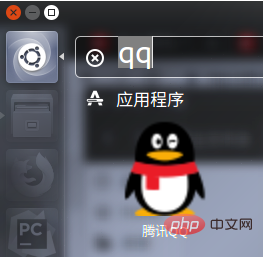 Operation and Maintenance
Operation and Maintenance
 Linux Operation and Maintenance
Linux Operation and Maintenance
 Can qq be used in linux operating system?
Can qq be used in linux operating system?
Can qq be used in linux operating system?
Linux operating system can use qq. The method of installing and using qq is: 1. Check your system architecture and version through the "uname -a" command; 2. On the linuxqq download page, select the installation package according to the system version ; 3. Install "gtk2.0" through "sudo apt install libgtk2.0-0"; 4. Install linuxqq through "sudo apt install -y" command.

The operating environment of this tutorial: linux5.9.8 system, linuxqq 1.0.1, Dell G3 computer.
Can I use qq on Linux operating system?
able.
How to install QQ under Linux:
- ##linuxqq download page: https://im.qq.com/linuxqq /download.html
- First use
uname -a
to check your system architecture and version - Select the architecture:
x64 (x86_64, amd64), arm64 (aarch64), mips64 (mips64el)
- Select the installation package according to the system version:

- Installing this software requires gtk2.0. If not, you need to install it, for example:
sudo apt install libgtk2.0-0 # Ubuntu
sudo yum install gtk2. x86_64 # centos
- Download the installation package and install it, for example:
sudo ./linuxqq_1.0.1-b1-100_x86_64.sh
sudo rpm -ivh linuxqq_1.0.1-b1-100_mips64el.rpm
sudo dpkg -i linuxqq_1.0.1-b1-100_armhf.deb
sudo apt install -y /path/to/linuxqq_1.0.1-b1-100_amd64. deb
sudo pacman -U linuxqq_1.0.1-ci-94_x86_64.pkg.tar.xz- Although the installation package is only 10.8MB, it takes 27GB after installation. This is too big!
- After installation, you can use it:

- The login interface is as follows:

- The interface after logging in is very retro, giving me the feeling of using qq on WIndow a few years ago. There are few functions in this release, and it is not easy to use QAQ. For example, emoji cannot be turned off when I click on it in the chat interface. It may also be a problem with my computer.
- Uninstallation: Try to uninstall Linux QQ using the corresponding method used during installation (refer to the instructions of the system installation package manager used). For example:
sudo rpm -e linuxqq
sudo dpkg -r linuxqq
The above is the detailed content of Can qq be used in linux operating system?. For more information, please follow other related articles on the PHP Chinese website!

Hot AI Tools

Undresser.AI Undress
AI-powered app for creating realistic nude photos

AI Clothes Remover
Online AI tool for removing clothes from photos.

Undress AI Tool
Undress images for free

Clothoff.io
AI clothes remover

AI Hentai Generator
Generate AI Hentai for free.

Hot Article

Hot Tools

Notepad++7.3.1
Easy-to-use and free code editor

SublimeText3 Chinese version
Chinese version, very easy to use

Zend Studio 13.0.1
Powerful PHP integrated development environment

Dreamweaver CS6
Visual web development tools

SublimeText3 Mac version
God-level code editing software (SublimeText3)

Hot Topics
 1378
1378
 52
52
 How do I use regular expressions (regex) in Linux for pattern matching?
Mar 17, 2025 pm 05:25 PM
How do I use regular expressions (regex) in Linux for pattern matching?
Mar 17, 2025 pm 05:25 PM
The article explains how to use regular expressions (regex) in Linux for pattern matching, file searching, and text manipulation, detailing syntax, commands, and tools like grep, sed, and awk.
 How do I monitor system performance in Linux using tools like top, htop, and vmstat?
Mar 17, 2025 pm 05:28 PM
How do I monitor system performance in Linux using tools like top, htop, and vmstat?
Mar 17, 2025 pm 05:28 PM
The article discusses using top, htop, and vmstat for monitoring Linux system performance, detailing their unique features and customization options for effective system management.
 How do I implement two-factor authentication (2FA) for SSH in Linux?
Mar 17, 2025 pm 05:31 PM
How do I implement two-factor authentication (2FA) for SSH in Linux?
Mar 17, 2025 pm 05:31 PM
The article provides a guide on setting up two-factor authentication (2FA) for SSH on Linux using Google Authenticator, detailing installation, configuration, and troubleshooting steps. It highlights the security benefits of 2FA, such as enhanced sec
 How do I manage software packages in Linux using package managers (apt, yum, dnf)?
Mar 17, 2025 pm 05:26 PM
How do I manage software packages in Linux using package managers (apt, yum, dnf)?
Mar 17, 2025 pm 05:26 PM
Article discusses managing software packages in Linux using apt, yum, and dnf, covering installation, updates, and removals. It compares their functionalities and suitability for different distributions.
 How do I use sudo to grant elevated privileges to users in Linux?
Mar 17, 2025 pm 05:32 PM
How do I use sudo to grant elevated privileges to users in Linux?
Mar 17, 2025 pm 05:32 PM
The article explains how to manage sudo privileges in Linux, including granting, revoking, and best practices for security. Key focus is on editing /etc/sudoers safely and limiting access.Character count: 159
 Key Linux Operations: A Beginner's Guide
Apr 09, 2025 pm 04:09 PM
Key Linux Operations: A Beginner's Guide
Apr 09, 2025 pm 04:09 PM
Linux beginners should master basic operations such as file management, user management and network configuration. 1) File management: Use mkdir, touch, ls, rm, mv, and CP commands. 2) User management: Use useradd, passwd, userdel, and usermod commands. 3) Network configuration: Use ifconfig, echo, and ufw commands. These operations are the basis of Linux system management, and mastering them can effectively manage the system.
 The 5 Pillars of Linux: Understanding Their Roles
Apr 11, 2025 am 12:07 AM
The 5 Pillars of Linux: Understanding Their Roles
Apr 11, 2025 am 12:07 AM
The five pillars of the Linux system are: 1. Kernel, 2. System library, 3. Shell, 4. File system, 5. System tools. The kernel manages hardware resources and provides basic services; the system library provides precompiled functions for applications; the shell is the interface for users to interact with the system; the file system organizes and stores data; and system tools are used for system management and maintenance.
 Linux Maintenance Mode: Tools and Techniques
Apr 10, 2025 am 09:42 AM
Linux Maintenance Mode: Tools and Techniques
Apr 10, 2025 am 09:42 AM
In Linux systems, maintenance mode can be entered by pressing a specific key at startup or using a command such as "sudosystemctlrescue". Maintenance mode allows administrators to perform system maintenance and troubleshooting without interference, such as repairing file systems, resetting passwords, patching security vulnerabilities, etc.






